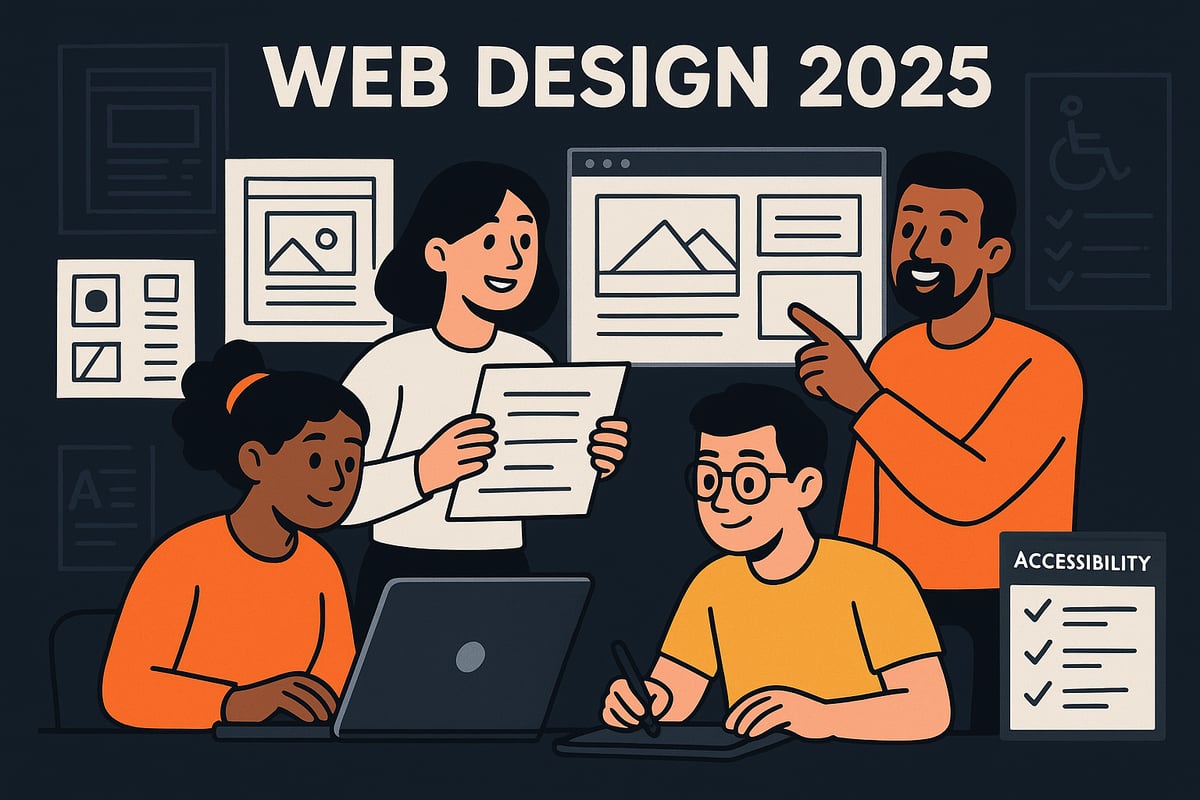The Essential Guide to Design of Web for 2025
Imagine stepping into a future where the design of web is not just visually compelling, but also seamlessly anticipates every user need. As digital expectations rise, mastering the design of web becomes essential for businesses, designers, and developers alike. This guide unpacks the principles, trends, and strategies that will define success online in 2025. Discover how emerging technologies, best-in-class UX, and accessibility shape tomorrow’s digital experiences. Ready to future-proof your skills and build websites that truly stand out? Let’s explore the path to creating user-centred, impactful online spaces for the next era.
The State of Web Design in 2025: Key Trends and Innovations
The design of web is transforming rapidly as we approach 2025. Designers, developers, and businesses must stay ahead by embracing the latest principles and technologies. Let us explore the pivotal trends reshaping the digital landscape this year.

The Rise of AI and Automation in Web Design
AI is fundamentally changing the design of web, making workflows smarter and more efficient. AI-powered design tools now suggest layouts, generate content, and automate image editing, helping teams create at unprecedented speed. Platforms like Figma have integrated AI plugins, while Wix ADI personalises websites for users in real time.
As AI becomes mainstream, personalisation is delivered instantly, adapting sites to each visitor’s needs. According to AI in Web Design: Tools and Adoption, 93% of web designers now use AI tools in their daily work. This shift marks a new era in the design of web, where automation enhances creativity and efficiency.
Minimalism and Maximalism: The New Visual Dichotomy
In 2025, the design of web has split into two striking visual directions. Some brands embrace ultra-minimal interfaces, focusing on space, simplicity, and clarity. Others go bold, using expressive visuals, layered graphics, and vivid colours to make a statement.
This dichotomy reflects a deeper brand strategy. Companies seeking calm and focus choose minimalism, while those wanting to stand out opt for maximalist visuals. Leading 2025 website showcases highlight both styles, showing that the design of web is about aligning visual identity with user expectations.
Microinteractions and Dynamic Animations
Subtle motion and interactive elements are now essential in the design of web. Microinteractions guide users, confirm actions, and provide instant feedback. These tiny animations, from button hovers to loading spinners, keep engagement high without overwhelming the interface.
Performance remains a priority. Designers use lightweight animations and optimised code to ensure fast load times. E-commerce platforms, for example, report higher conversion rates after adding microinteractions, proving their value in the design of web for 2025.
Sustainable and Ethical Web Design
Sustainability is a core principle shaping the design of web. Eco-friendly hosting, optimised images, and efficient coding practices reduce energy use and environmental impact. Data shows that sustainable sites load 30% faster and have lower bounce rates, making green UX both ethical and practical.
Accessibility and inclusivity are now non-negotiable. Ethical design of web means considering all users, including those with disabilities. This shift ensures that every website reflects responsibility and care, both for people and the planet.
Voice, Gesture, and Multimodal Interfaces
The design of web in 2025 is no longer confined to clicks and taps. Voice navigation and gesture-based controls are expanding, making sites more accessible than ever. Multimodal interfaces allow users to interact through speech, touch, or movement, breaking down traditional barriers.
Retail sites are already integrating voice search, enabling shoppers to find products hands-free. As the design of web evolves, these technologies promise richer, more inclusive user experiences.
Data-Driven Design Decisions
Every decision in the design of web is now backed by data. Analytics tools and user feedback inform changes, ensuring sites meet real needs. Teams use A/B testing and continuous improvement cycles to refine layouts, content, and features.
This approach creates a dynamic, responsive design of web that evolves with its audience.
User Experience (UX) and Accessibility: Non-Negotiables for 2025
In the rapidly shifting landscape of digital interaction, user experience and accessibility are no longer optional. They are essential pillars in the design of web for 2025. A future-ready website must deliver seamless journeys for all users, regardless of device or ability. Let’s explore the core principles driving UX and accessibility this year.

Evolving UX Principles for Modern Audiences
Modern audiences expect more than good looks—they demand intuitive, personalised experiences. The design of web in 2025 hinges on user-centric navigation and adaptive interfaces. Personalisation engines now shape content and recommendations in real time.
For instance, Netflix’s dynamic content adjusts to viewers’ preferences, ensuring every interaction feels relevant. Consistent, predictable navigation builds trust and reduces friction. If you want to stay ahead, study the Creative Design Strategy Guide 2025 for actionable insights on modern UX thinking.
- Prioritise clarity and simplicity in navigation
- Use adaptive layouts that adjust to user behaviour
- Integrate personalisation while respecting privacy
The design of web must meet users where they are and anticipate their needs.
Accessibility as a Core Requirement
Accessibility is now a non-negotiable aspect of the design of web. Legal frameworks like WCAG 2.2 and the anticipated 3.0 standard set clear requirements for inclusive digital experiences.
Every website should offer:
- Sufficient colour contrast for readability
- Scalable fonts for all vision levels
- Full keyboard navigation support
With 15% of the global population living with a disability (WHO), accessible design is both an ethical and business imperative. The design of web that overlooks accessibility risks alienating users and facing legal consequences.
Mobile-First and Responsive Design
As mobile usage has overtaken desktop, the design of web must put mobile first. Over 60% of internet traffic now comes from mobile devices. Responsive design ensures your site adapts fluidly to any screen size.
Key best practices:
- Employ fluid grids and flexible images
- Test layouts across devices and orientations
- Use adaptive menus and touch-friendly elements
Responsive e-commerce platforms are seeing higher sales and lower bounce rates. In 2025, mobile-first is not just a trend, it is the foundation of the design of web.
Inclusive Content and Multilingual Design
Global reach requires content that resonates across cultures. The design of web in 2025 means localising language, imagery, and tone for diverse audiences.
Consider these steps:
- Use translation tools to create multilingual sites
- Select images that reflect cultural diversity
- Adapt content to regional preferences
Leading brands now offer regionalised web experiences, proving that inclusive content drives engagement. The design of web should make every visitor feel seen and understood.
User Testing and Feedback Loops
Continuous improvement is vital in the design of web. User testing and feedback loops uncover pain points and spark innovation.
Effective methods include:
- Heatmaps to visualise engagement
- Session recordings to spot friction
- User surveys for direct input
Iterative updates based on real user data ensure your site evolves with changing needs. In 2025, the most successful design of web projects are those that embrace feedback and never stop improving.
Technological Foundations: Building for Performance and Scalability
The design of web in 2025 is fundamentally shaped by technological progress. Performance, scalability, and adaptability are no longer optional. They are the foundation for any successful website. Let us explore the pillars that enable modern web experiences to thrive in a rapidly evolving digital world.

Core Web Vitals and Site Speed Optimisation
Speed is a cornerstone of the design of web for 2025. Google’s Core Web Vitals have become critical ranking factors, focusing on metrics like Largest Contentful Paint (LCP), First Input Delay (FID), and Cumulative Layout Shift (CLS).
To optimise site speed, designers employ techniques such as lazy loading, image compression, and code minification. These methods ensure that users experience minimal delays and smooth interactions. In fact, 53% of visitors will leave a site if it takes more than three seconds to load.
| Optimisation Technique | Impact on Speed | Ease of Implementation |
|---|---|---|
| Lazy Loading | High | Moderate |
| Image Compression | Significant | Easy |
| Code Minification | Moderate | Moderate |
The design of web now demands a performance-first mindset, making speed a non-negotiable aspect for every project.
Progressive Web Apps (PWAs) and Headless CMS
The design of web increasingly incorporates PWAs and headless CMS solutions. PWAs deliver app-like experiences, offline access, and push notifications, enhancing user engagement and accessibility.
With a headless CMS, content is decoupled from presentation, allowing developers to use APIs to deliver content across platforms. This approach provides flexibility and scalability for businesses aiming to grow without limitations.
Retailers adopting PWAs have seen significant increases in engagement and conversion rates. The design of web must now consider these technologies essential for creating seamless, scalable user experiences.
Security and Privacy by Design
Security is at the core of the design of web, especially as regulations like GDPR and CCPA shape digital practices. Privacy-first architecture, secure authentication, and robust data protection are fundamental requirements for modern sites.
Designers and developers must implement HTTPS, manage cookies responsibly, and provide transparent privacy policies. Users expect their data to be protected at every touchpoint.
By prioritising security, the design of web builds trust and ensures compliance, reducing the risk of breaches and reputational harm for businesses.
Cloud Infrastructure and Serverless Technology
Cloud infrastructure and serverless technology have revolutionised the design of web. Cloud hosting offers scalability and reliability, allowing sites to handle sudden traffic spikes without interruption.
Serverless functions enable dynamic content generation without the need for traditional servers. This approach reduces costs, improves performance, and simplifies maintenance.
For instance, media companies rely on these technologies to manage viral content efficiently. The design of web now leverages the cloud to ensure sites remain resilient, responsive, and cost-effective.
Future-Proofing with Modular and API-Driven Design
Adopting a modular, API-driven approach is vital for the design of web that stands the test of time. Component-based frameworks like React, Vue, and Svelte allow teams to build reusable elements, speeding up development and updates.
API-first strategies enable seamless integration with other platforms and services. Here’s a simple example of a modular component structure:
// Button component (React)
function Button({ label, onClick }) {
return <button onClick={onClick}>{label}</button>;
}
For a deeper dive into foundational choices, see our Web Design and Development Services page.
This flexible, future-ready approach ensures the design of web can adapt to new trends and business needs quickly and efficiently.
Step-by-Step Guide: Designing a Future-Ready Website for 2025
Building a future-ready website requires a strategic approach. Every decision in the design of web projects for 2025 must balance innovation, usability, and scalability. By following a structured process, you can ensure your website stands out and delivers lasting value.

Step 1: Research and Discovery
Start the design of web projects with thorough research and discovery. Interview stakeholders to understand business goals and user needs. Analyse competitors to spot gaps and opportunities in the digital landscape.
Create detailed audience personas. This will guide the design of web content, features, and interfaces. Use analytics and industry reports to identify trends influencing user expectations for 2025.
Establish a clear project scope based on data-driven insights. This foundation ensures the design of web solutions aligns with both user demands and business objectives.
Step 2: UX Strategy and Wireframing
Effective UX strategy shapes the design of web experiences that feel intuitive and engaging. Map out user journeys to visualise how visitors interact with your site. Develop wireframes and prototypes to test navigation and layout ideas early.
Leverage tools like Figma, Adobe XD, or Sketch to streamline collaboration. AI-powered plugins are transforming the design of web prototypes, enabling rapid iteration and smart suggestions. For more insight, see AI in Web Design: Tools, Pros & Cons, which explores how technology is changing workflows.
By investing in early-stage UX strategy, you ensure the design of web interfaces that adapt to evolving user needs.
Step 3: Visual Design and Branding
Visual identity is central to the design of web in 2025. Define a cohesive colour palette, typography, and imagery that reflect your brand's essence. Incorporate current trends such as gradients, 3D elements, and bold type to create visual impact.
Consistency across all touchpoints is vital. Develop design systems or style guides to maintain brand integrity. Use mood boards to explore creative directions and gather feedback before finalising visuals.
Remember, strong branding in the design of web projects fosters trust and recognition.
Step 4: Accessibility and Inclusivity Checks
Accessibility is a non-negotiable aspect of the design of web today. Conduct both automated and manual audits to ensure compliance with WCAG 2.2 standards. Check colour contrast, font sizes, and keyboard navigation for usability.
Integrate ARIA labels and support for assistive technologies. Test with users who have diverse abilities to identify barriers. Make inclusivity a core value in the design of web, ensuring everyone can access and enjoy your site.
Addressing accessibility from the outset reduces costly fixes later and broadens your audience reach.
Step 5: Development and Technology Stack Selection
Choosing the right technology is crucial for the design of web platforms built for longevity. Evaluate frameworks like React, Vue, or Svelte based on your needs. Select a CMS that supports flexibility and scalability, such as headless WordPress or Contentful.
Ensure compatibility with PWAs for offline access and seamless user experiences. Opt for reliable hosting solutions that support growth and security. The right stack enables the design of web projects that adapt as technology evolves.
Collaboration between developers and designers is key during this phase.
Step 6: Performance Optimisation and SEO
Performance is a major ranking factor in the design of web for 2025. Compress images, implement code splitting, and enable caching to speed up load times. Pay attention to Google's Core Web Vitals when evaluating site health.
Optimise on-page SEO with semantic HTML and structured data. Use targeted keywords and descriptive meta tags. Regularly audit and refine technical SEO to maintain visibility.
A fast, optimised design of web not only improves rankings but also enhances user satisfaction.
Step 7: Testing, Launch, and Iteration
Before launching, conduct comprehensive testing across devices, browsers, and assistive technologies. Fix issues promptly to ensure a smooth experience for all users.
Develop a launch plan with phased rollouts and real-time monitoring. Use analytics and user feedback to guide ongoing improvements after launch. Treat the design of web as an ongoing process, not a one-time event.
Continuous iteration keeps your website competitive and relevant in 2025.
Branding and E-Commerce: Integrating Identity and Conversion
Building a powerful online presence in 2025 demands more than aesthetics. The design of web now fuses branding with conversion, creating experiences that are both memorable and results-driven. Below, we explore how to weave identity and commerce seamlessly.
Crafting a Memorable Digital Brand
A consistent digital brand is the cornerstone of the design of web in 2025. Brands that thrive online use cohesive colour schemes, bold typography, and distinctive imagery to stand out. Storytelling is central, enabling emotional connections with users across platforms.
Take inspiration from direct-to-consumer brands that use immersive narratives and unified visuals to build trust. For actionable strategies and real-world examples, explore Digital Branding Solutions Insights. Establishing a clear identity provides a competitive edge in a crowded market.
Conversion-Focused E-Commerce Design
In the design of web for e-commerce, every element influences conversion. High-performing sites use proven UX patterns, such as clear product images, concise descriptions, and frictionless checkout processes.
Consider these essentials:
- Prominent calls to action
- Guest checkout options
- Trust signals near payment sections
Data shows that optimised product pages and streamlined flows increase purchase rates. By aligning design choices with user intent, businesses boost both engagement and sales.
Personalisation and Customer Journey Mapping
Personalisation is a defining feature in the design of web for 2025. AI-driven recommendations, targeted offers, and dynamic content create journeys tailored to individual users.
Retailers map customer touchpoints to anticipate needs and deliver relevant experiences. Loyalty programmes and curated product suggestions drive higher average order values. By leveraging user data responsibly, businesses can foster long-term loyalty and repeat purchases.
The Role of Social Proof and Trust Signals
Trust is a crucial factor in the design of web for commerce. Displaying verified reviews, testimonials, and trust badges reassures visitors and reduces hesitation.
Showcasing social proof builds credibility quickly. Consider adding:
- Customer star ratings
- Security logos
- Real-time purchase notifications
These elements influence purchase decisions and can significantly improve conversion rates. A transparent and trust-driven approach ensures users feel confident from first click to final checkout.
Measuring Success: Analytics, KPIs, and Continuous Improvement
Success in the design of web relies on more than just stunning visuals. True impact comes from tracking, analysing, and refining every aspect of a website. Measuring performance ensures that your web projects not only meet user expectations but also drive tangible results.
Defining and Tracking Key Performance Indicators
Selecting the right KPIs is foundational for evaluating the design of web. These metrics transform abstract goals into measurable outcomes. Common KPIs include bounce rate, conversion rate, average session duration, and user engagement.
Below is a simple table summarising critical KPIs for modern web projects:
| KPI | Description | Why It Matters |
|---|---|---|
| Bounce Rate | % of users leaving after 1 page | Indicates engagement |
| Conversion Rate | % of visitors completing goals | Measures effectiveness |
| Session Duration | Time spent per visit | Reflects content value |
| Page Views/User | Avg. pages visited per user | Shows interest |
Setting clear targets for each KPI ensures the design of web aligns with business objectives. Regularly reviewing these indicators helps teams adapt to evolving user needs.
Leveraging Advanced Analytics Tools
Modern analytics platforms are essential for understanding how users interact with the design of web. Google Analytics 4 provides granular insights, while heatmap tools visualise real user behaviour, revealing where visitors click and scroll.
Session recordings and funnel analysis allow teams to pinpoint friction points. According to AI in Web Design Statistics, nearly 93% of designers now use AI-driven analytics to gain a competitive edge. These capabilities make it easier to refine landing pages and optimise user journeys.
Consistent use of analytics ensures continuous alignment between site performance and strategic goals for the design of web.
Continuous Improvement and Agile Iteration
Continuous improvement is vital for the ongoing success of the design of web. Agile methodologies encourage rapid prototyping and frequent testing, enabling swift adaptation to user feedback.
Teams can implement data-driven sprints, using insights from analytics and surveys to prioritise enhancements. Each iteration should address real user pain points, ensuring the design of web remains relevant and effective.
Regularly scheduled reviews and feedback loops foster a culture of growth and innovation.
Staying Ahead: Monitoring Trends and Competitors
Monitoring industry trends and competitor benchmarks is crucial for maintaining a leading edge in the design of web. Tools like trend trackers and competitor analysis platforms provide real-time insights into emerging best practices.
By staying informed, businesses can quickly adapt their strategies, ensuring that their design of web continues to meet and exceed user expectations. This proactive approach supports long-term digital success.
